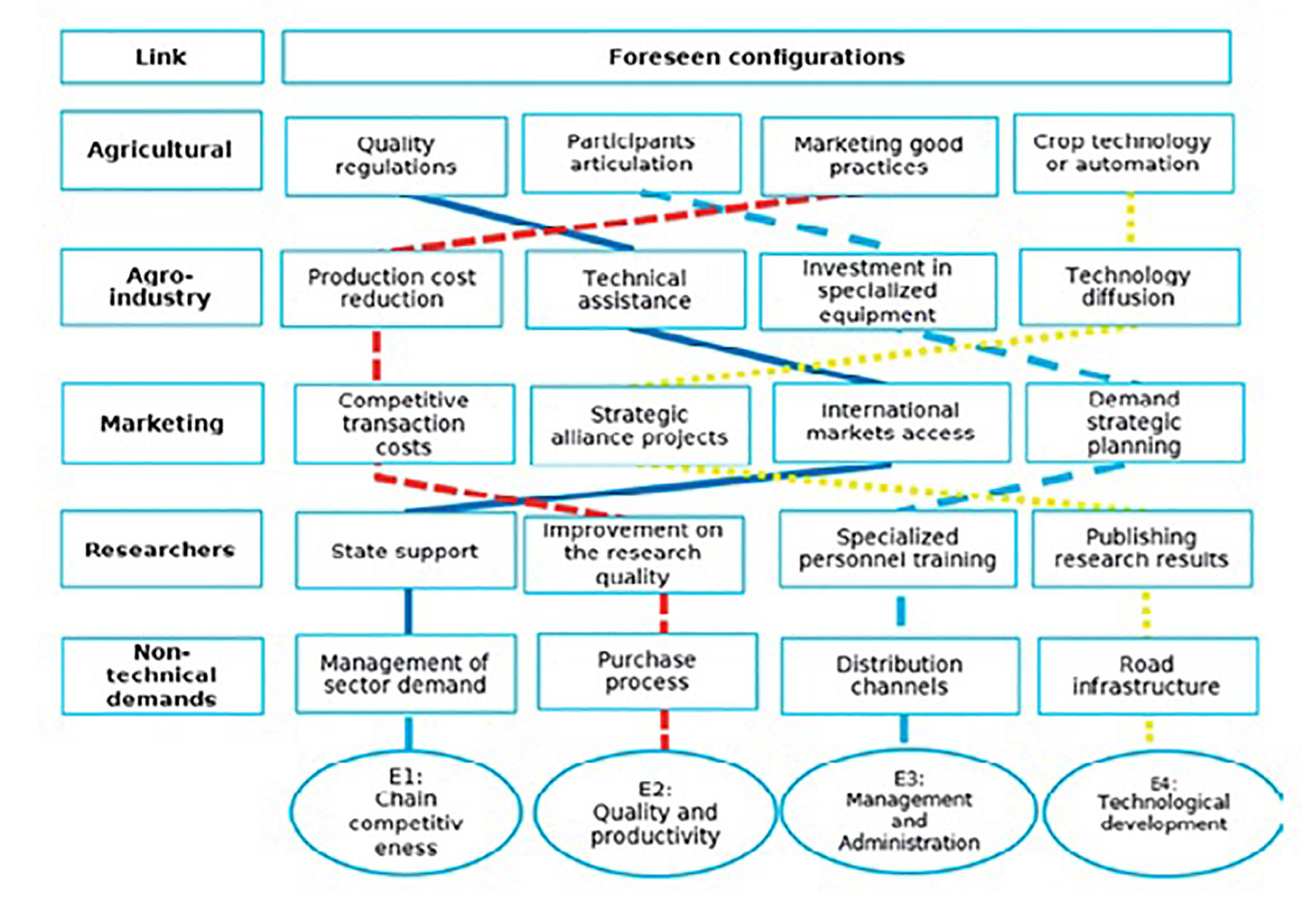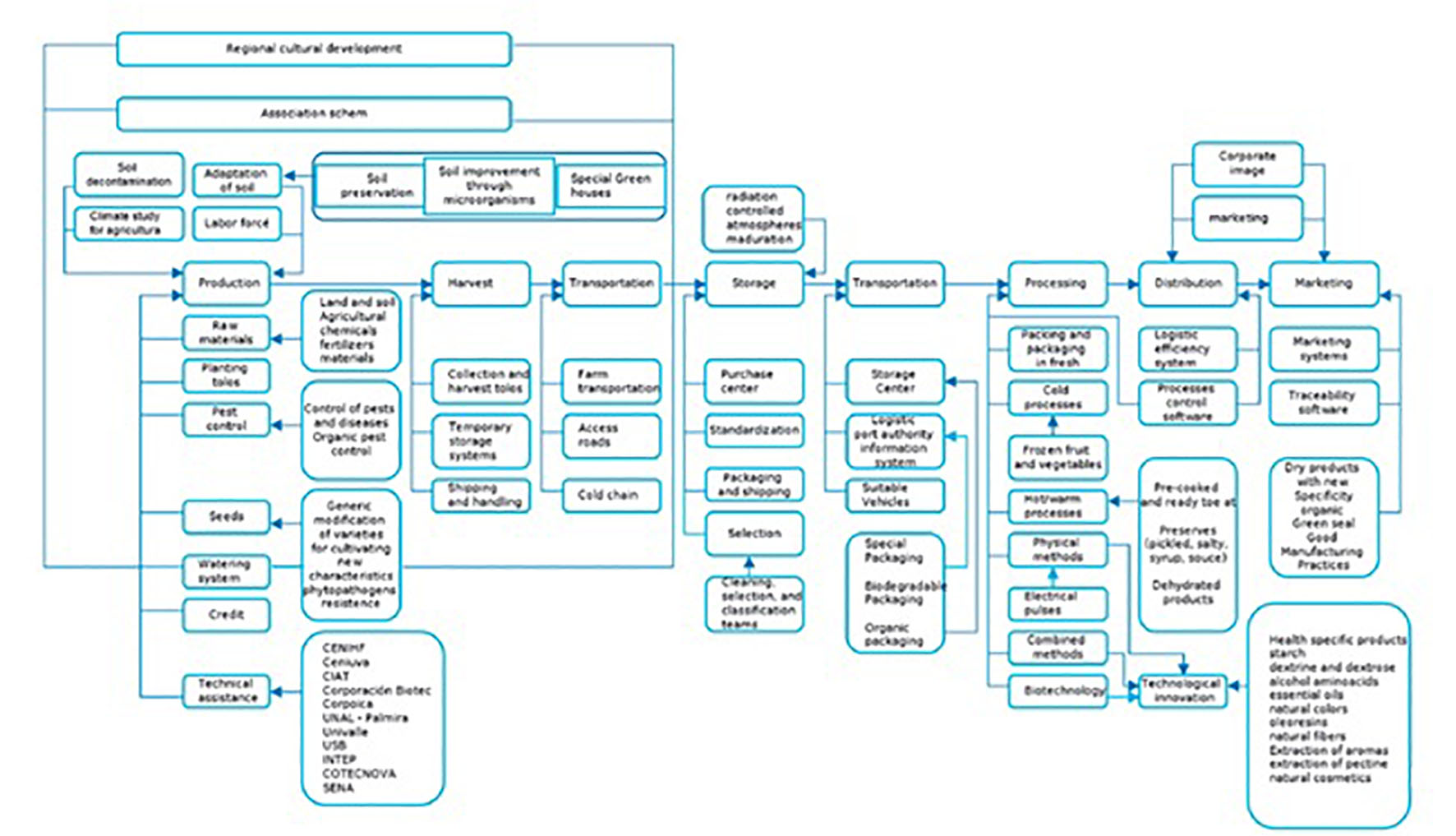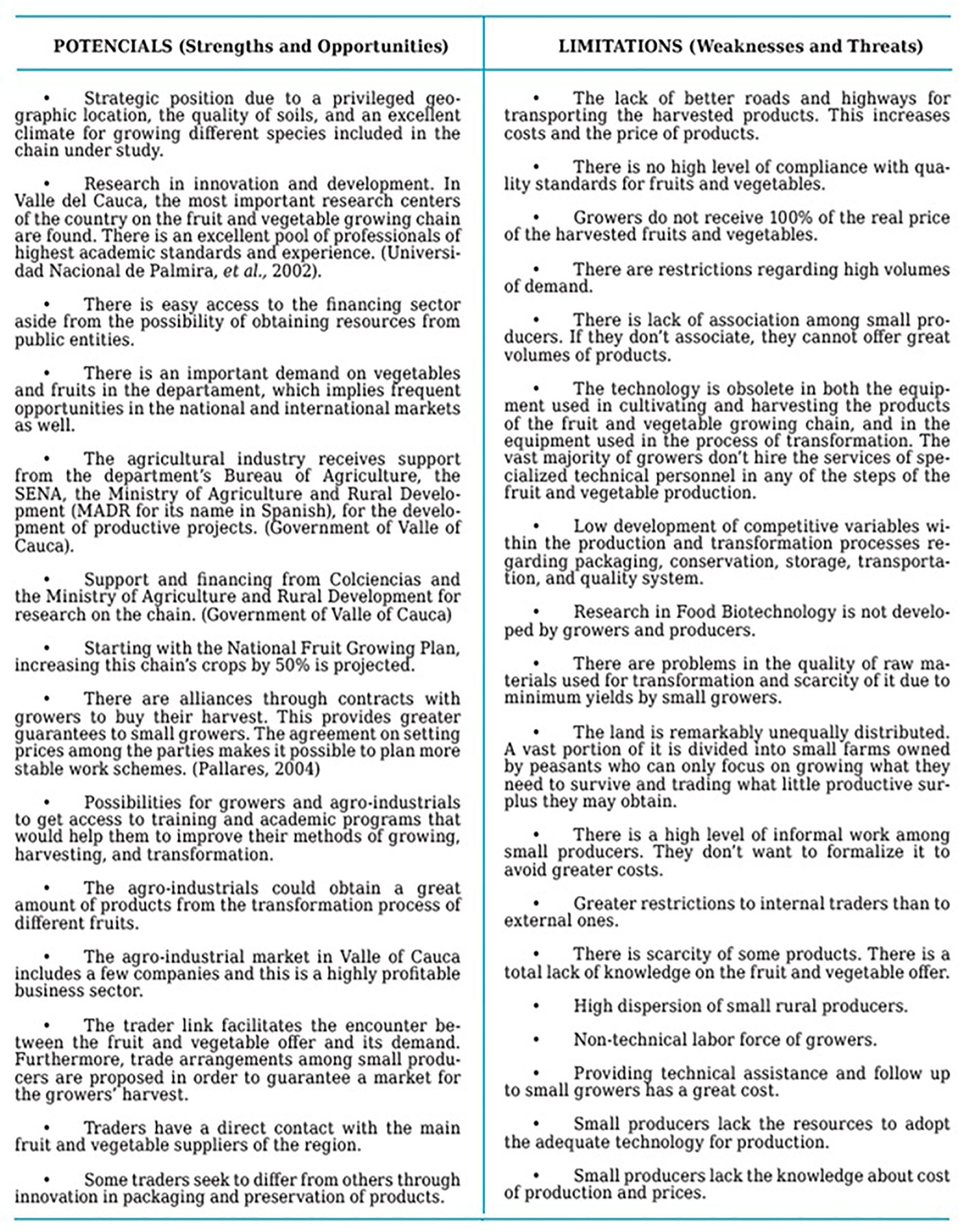1. Introduction
Determining technological demands or foreseeing technologies is a recent research field. This concept has positioned itself within the science and technology (C&T for its name in Spanish) management (Mojica, 1991) and it has been possible due to its large period of development in scientific research, the declining of available financial resources for research, and a growing demand for results to justify the public and private investments in C&T.
The concept of productive chain has been introduced recently in the field of agricultural research (Castellanos, Torres and Domínguez (2009) (CICDA, 2004). The process of strategic planning made for the agricultural research organizations makes evident the need to reform the traditional approach that was centered around the rural producer and the farm. This process has a wider vision: it includes the market, the other social actors in agricultural production with their needs and demands. Likewise there are opportunities in both the national and international markets for a variety of fresh and processed Colombian products. In this sense, the agricultural fruit and vegetable processing industry could play an important economic dynamic and social role in the fruit and vegetable growing sector as it impacts positively the integration of industrial production generating jobs, stimulating an increase in agricultural production, technological and industrial development in the sector aside from producing an increase in consumption and diversification as well as the improvement of some varieties, generating interest in the international markets for the exportation of fruits and vegetables grown in Colombia (Lopera, Homez, 2009), (FAO, 2013).
However, in the face of such reality, it is also important to foresee the social, technological, and marketing changes related to the agricultural industry in this country and, hence, build a future. For that reason, it is a priority to apply the analysis, methods and tools such as those of prospective thinking that would allow to establish future visions through the construction of scenarios with the purpose of “improving the available information that would set the basis for strategic decision making”. Gomes de Castro, Valle de Lima, Goedert, Filho and Pereira (1998). The use of prospective thinking permits a greater comprehension of the interactions between different actors and institutions that constituted the chain and it also involves a long-term vision. That is how it is sought for the actors involved in the chain to foresee the changes that might occur, using prospective analysis, exploring opinions and the perception of the chain interest groups. The application of the prospective process to the study of Valle del Cauca fruit and vegetable growing chain permits the establishment of that future vision by its actors in a consensus manner in order to reach their common goal: improving the chain’s competitiveness.
2. Methodology
This research was developed in two phases: the diagnostic and the prospective. Strategic management tools were used in both of them as well as prospective methods. The selected methodological instruments were applied according to the steps taken in each phase of the process (Figure 1). In order to reach the goal, the study started with the present conditions of the fruit and vegetable growing chain. After that, the probable and possible scenarios were established as well as the definition of a betting scenario and the strategies to accomplish it. The present study on the chain’s future scenarios was strengthen by the methodology of the Brazilian Agricultural Research Company EMBRAPA that gave support to the Ministry of Agriculture and Rural Development (MADR for its name in Spanish) in the implementation in the implementation of productive integration developement programs (2006 - 2010) under the productive chain model (Gomes, et al., 1998).
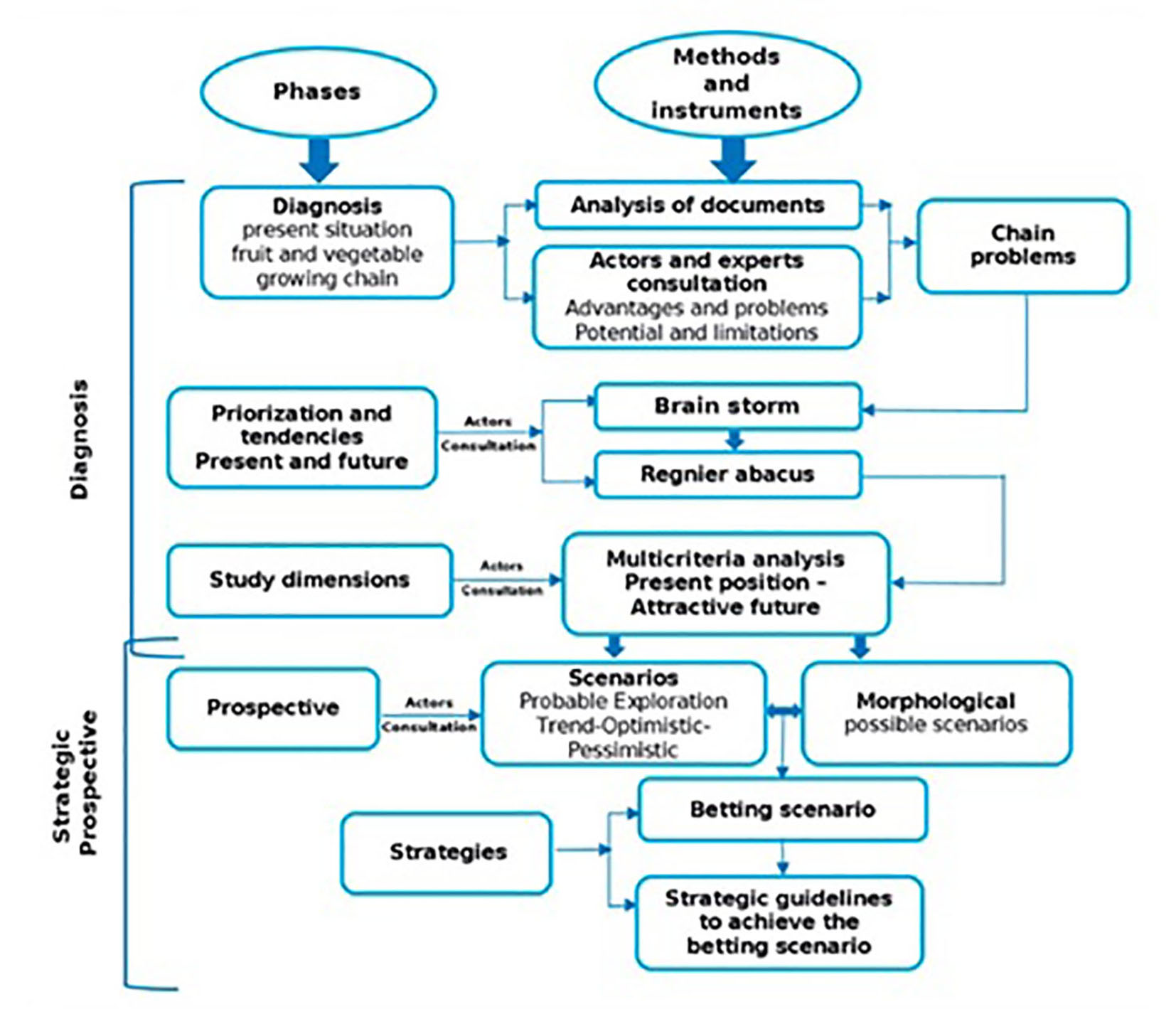
Figure 1 Process for the development of a strategic prospective plan, applied to producing chains, scenarios methods. Source: author own elaboration
Phase 1: Diagnostic phase. The analysis of the chain’s information and its performance started with the agricultural producers followed by majority and minority traders, industrial processors and it ended with the researchers. This was done mainly by applying documental analysis. Secondly, a consultation to the actors was carried out through a survey applied to them and through a deep interview made to experts in-depth the chain. Afterwards, the diagnosis was completed with a brain storm, and the Regnier Abacus technique was applied. That technique made it possible to prioritize problematic variables and to explore their tendencies.
Thirdly the diagnostic phase ended organizing the problematic variables in six (6) dimensions (variable subgroups): mobility, economic, social, and cultural aspects, education and technology. Once the dimensions were organized, the actors were consulted on their perceptions over the “present position (x)” of each dimension and its “attractive future (y). After that, each dimension was placed in a Cartesian plain, according to the (x, y) coordinates of each one (Figure 2).
This multi-criteria technique reduces the complexity of the system of variables and the uncertainty of its future behavior.
Phase 2: Prospective and strategy. In the first place, the method of applied scenarios in the study of the fruit and vegetable growing chain was supported by the results of the different prospective techniques of diagnosis used in phase 1 and recommended by authors like Godet, M., (2000) in his “prospective tool box” and by Van Der Heijdin, K. (1998) in “scenarios”. These results permitted to create the “base” of the scenarios by being the starting point for its construction.
In the second place, the identification of probable explored scenarios proceeded. Three scenarios were pointed out: tendency, optimistic (favorable), and pessimistic (unfavorable); each one of them bearing a hypothesis group with probabilities of future occurrence according to the actors’ and experts’ perception and to the dimesions’ behavior. The method of morphological analysis made it possible to identify complementary results and to explore the field of possible future scenarios for the chain. In essence, “a scenario is no more than the road to combine a configuration given by its different components, and precisely in the case of morphological analysis, the ‘morphological space’ defines the range of the possible scenarios and their combinations with higher precision (Riffo, 1997). This method allows to decompose the studied system (fruit and vegetables growing chain) in essential dimensions and to study the possible combinations of these different dimensions (Godet, 2000).
Thirdly the betting scenario was defined. This scenario was determined from the exploratory, probable and possible scenarios shown by the morphological space. For this purpose, the favorable and unfavorable consequences of each one of them were analyzed. The selected image or bet is the desired scenario which shows ruptures with respect to the probable scenario and it is the best possible one of all the identified scenarios. Finally, the study ended with the strategic guidelines. Those are organizational guidelines that include strategies and actions geared towards the non-technological demands and also technological guidelines that refer to the set of research, development, and innovation projects, the purpose of which is strengthening the technological demands of the Valle del Cauca fruit and vegetable growing chain for the 2019 horizon (Figure 1).
3. Discussion
3.1. Fruit and Vegetables Productive Chain
The analysis’s objective is the fruit and vegetables productive chain. Different agents participated in this from the harvesting process to its consumption; whether it was final or as an agricultural input. The chain is illustrated in Figure 3.
3.1.1. Producer
He is responsible for the first stage in the productive chain. He has great experience in the traditional harvesting process, but his technological capacity is low or non-existent. Since fruits and vegetables are part of the Colombian family’s basic diet, its production is geared towards supplying mainly the regional food demand in each department.
3.1.2. Wholesale Trade
The intermediate traders among the growers and wholesale distributors normally act as buyers. In most cases they are agents different from the grower. However, sometimes the producer is directly responsible for the storage and commercialization activity.
3.1.3. Retail Traders
The retail trade channels are classified as traditional and modern. The first one is found in market plazas, neighborhood stores, self-service, and specialty stores. The second includes supermarket chains. In fact, market plazas are the most traditional commercialization channel. These plazas are responsible for supplying the demand in cities and small towns.
3.1.4. Wholesale Distributors
They are specially located in distribution centers. They purchase vegetables mainly through transactions with intermediate traders. Only in few cases they trade directly with the growers. Likewise, the wholesalers that manage greater volumes are responsible of providing the products to the supermarket chains.
4. Results
Many circumstances and events were identified from the responses to the survey performed on experts (Table 1) (Scarpetta and Escobar, 2009). These were classified as follows: mobility, economy and financing, research and technology, and social experts in education, training, and culture.
4.1. Prospective Phase Results
Using the materials from the diagnostic phase (Tables 1 and 2), two workshops were designed to create a shared vision for the the development of each link in the fruit and vegetable growing chain in Valle del Cauca which were applied to this productive chain. Questions about the future of this chain were included in these workshops. Actors, experts, and researchers proposed their visions for the 2019 horizon and on finding solutions to present problems and limiting factors. Furthermore, the results from the priorities and tendencies that the chain was showing were also presented in these workshops. These priorities and tendencies were being systematized in the Regnier Abacus that shows the perception the actors have for both, the present and future of the chain’s conditions. The system’s variables were then grouped in six large dimensions. After that, the workshop participants were consulted on the present development position and on its attractive future (Figure 4) for each dimension. This exercise called multi-criteria facilitated the creation of an interphase between the diagnostic results and the scenarios design (Medina and Ortegón, 1997).
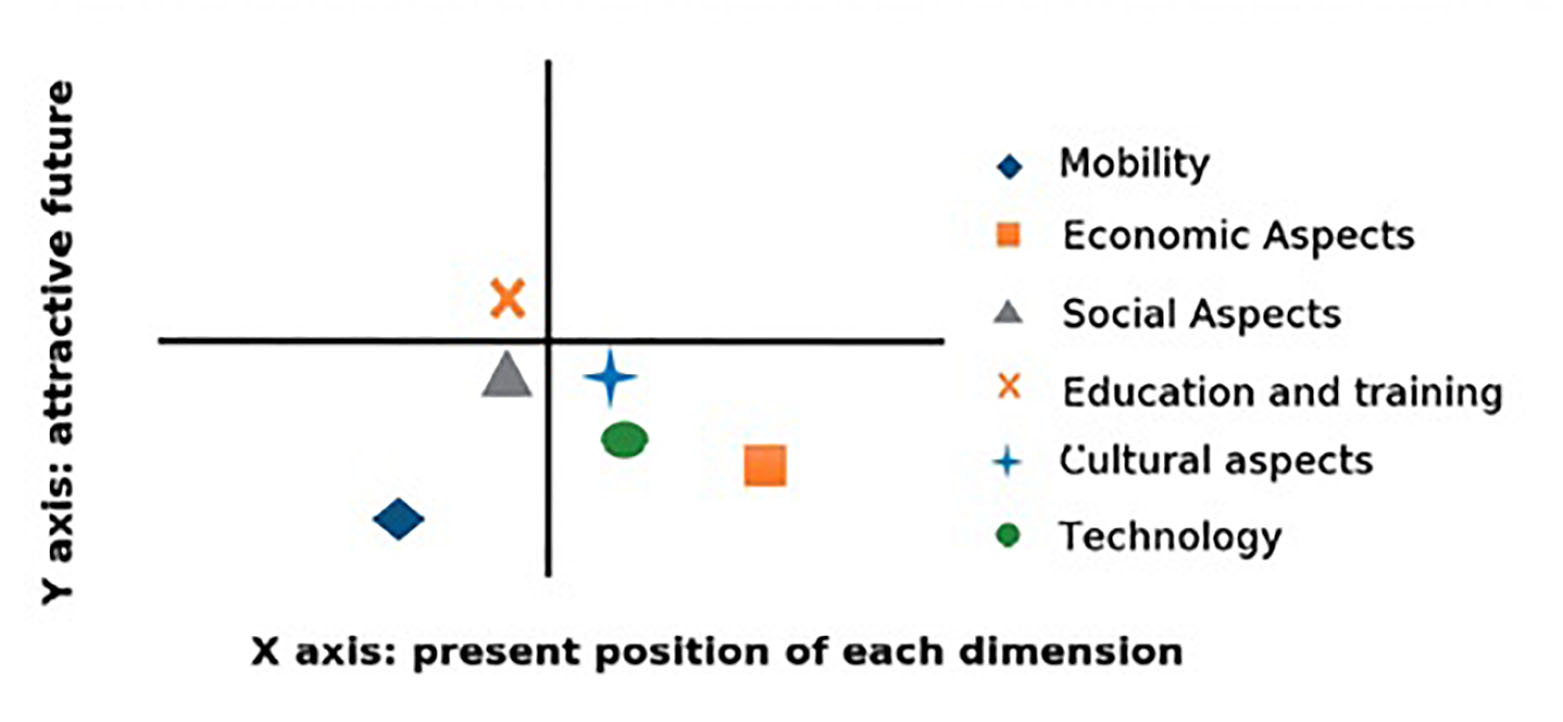
Figure 4 Multi-criteria analysis: present position - attractive future for each dimension. Workshop with experts. Source: Scarpeta, et al. 2009 .
Using the score given by the experts, the accumulated average resulting from the present state and the attractive future analysis was calculated. (Helbroner, 1996). In Figure 4, we can observe that the unfavorable behavior dimensions are: mobility, technology, and economic aspects. Moreover, the first of these is observed in the lower left quadrant which keeps an important distance from the dividing lines of the plain. Hence, the education dimension shows an unfavorable present position, but an attractive future for the chain’s participants.
The cultural and social dimensions reveal a less negative present position than the previous ones, but lower with respect to the attractive future that experts say it will have in 2019. Both are required for their importance in the change of attitude and associativity needed for the positive performance of the strategies to be executed. Their conception is not to be taken as isolated because their unified work will make possible the consolidation of a fruit and vegetable growing and productive chain that is attractive.
Likewise, it can be seen that the education and training dimension is located in the middle of the upper and lower quadrants due to the need of improvement in this area for each of the chain’s links. In fact, their score on attractive aspects was the highest because the strategy of greater betting that each expert proposed from their own point of view is a unified work among participants, starting from the generalized education systems and the appropriation of technology in the productive and commercialization processes.
Based on Figure 4, it is possible to conclude that the dimensions’ situation regarding their performance in the fruit and vegetable growing chain is critical since the present data reported by the experts does not show the ideal state in which they should be. For that reason, the starting point is negative for this chain. This is due to the high dispersion observed between one dimension and another, which means that the participants develop their initiatives or their own work in an isolated manner, without coordination, without fforeseeing synergy between links and, therefore, between its participants (Figure 5).
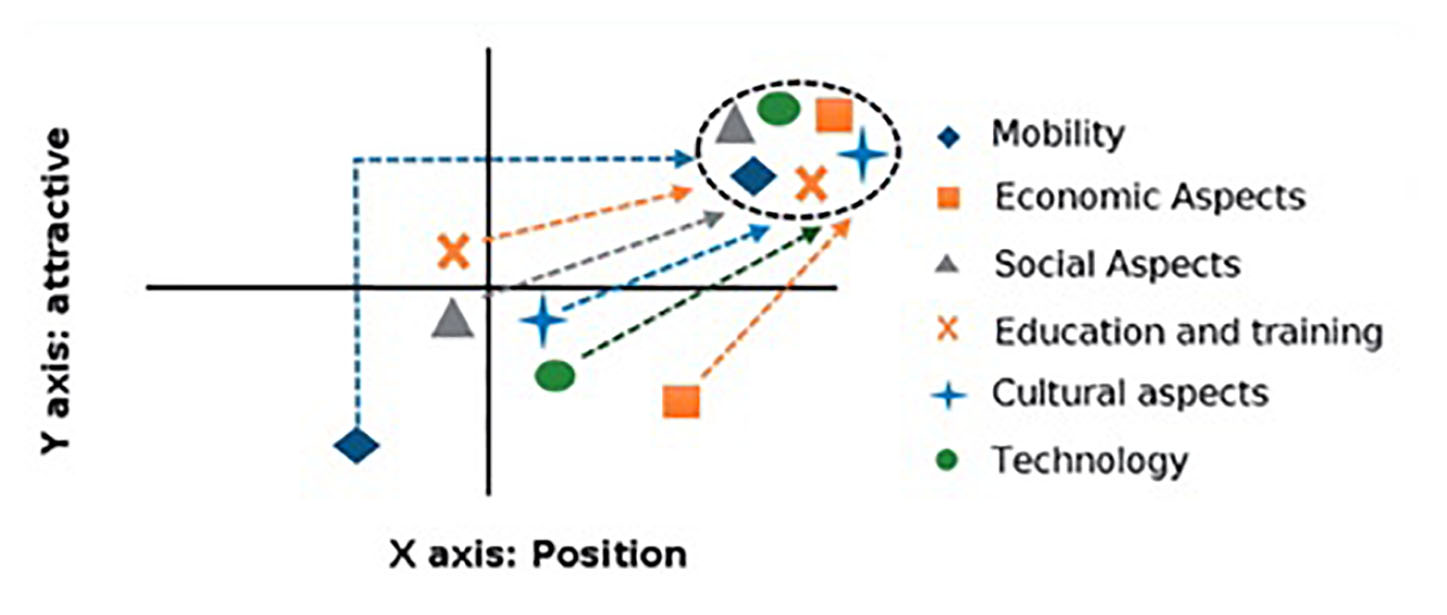
Figure 5 Multi-criteria analysis. Trajectory for reaching a better future state; workshop with experts. Source: Scarpeta, et al. 2009.
The trajectory every dimension should take in order to reach a better future state is proposed in the multi-criteria analysis. In this work it will be called the ideal trajectory for 2019. The trajectories shown in figure 4, in general, may not be short. This is the case of the education and training dimension, which is located in the middle of the upper left and right quadrants. The ideal trajectory for this dimension is definitely to pass the upper right quadrant, developing education programs that would allow the participants and the experts to perceive a change in the agriculture conception. That is, that agriculture would not continue to be seen as a domestic or survival activity.
The education, training, and mobility dimensions’ trajectories enclose the others in a 90° angle, in perpendicular projections. These are the ones with longer roads to follow in order to reach the ideal state for the 2019 horizon. The most effective trajectory will be the one that would relate a significant rupture with the past, and from that it would rapidly locate itself in a favorable position without needing to be a perpendicular movement. The dotted circle located in the upper right quadrant exposes an optimistic future scenario (Jouvenel, 2004). All the dimensions in an ideal future state will be located in this circle when they create synergy among themselves. The main need (that should be worked on from now) is establishing and executing concrete and decisive tasks in which the chain’s actors would participate constantly.
4.2. Exploratory Scenarios
Based on the multi-criteria analysis results and on the second workshop with the experts, it was proceeded to formulate the exploratory scenarios, giving as a result three scenarios: a) tendency; b) optimistic; c) pessimistic.
4.2.1. Tendency Scenario
In the year 2019, the chain will continue to present some problems in the management of crops due to the lack of interest from thegrowers to train themselves in order to improve their productive activity. More than half of this sector will continue to be small due to the lack of articulation present within each link. The roads will continue to present strong damages due to too much use and, in some cases, there will be no adequate roads to make the access to crops possible. Hence, the cost of transportation will increase and, consequently, the competitiveness will continue to be low. There will be lack of planning and adequate selection of future production due to the lack of knowledge about the offer and demand of fruits and vegetables. Some progress in the agricultural technology will be perceived. However, it will be costly to put it in practice. The future will continue to be similar to the present.
4.2.2. Optimistic Scenario
We are in the year 2019. There will be increases in physical gain and reductions in costs of the growers’ goods. This will allow the industry to enter new international markets and replacing imported products for domestic ones. The need for science and innovation in the chain will be identified. Such needs are: technological research, information systems, training of labor force, markets and infrastructure. This will make it possible to overcome sanitary and phyto-sanitary barriers. The group of growers will start a permanent training program for the participants in the chain through research and technical centers. The culture of hiring will be consolidated among growers by establishing clear and precise regulations for both growers and producers so that the prices will be stable throughout the year.
By increasing investments in research processes, the agro-industry will lower costs of cold infraestructures, that way guaranteeing the quality of raw materials. A program for the diffusion of technologies for agro-industrial processing will be created. Products with increased value will be developed. This will make exporting fresh fruits possible. The industry will guarantee a permanent supply of raw materials to agro-industrial processors, starting with the development of a primary offer with a great scale of industrial crops introduced by the agro-industrials themselves. This link will make evident a strong internal articulation and the establishment of a direct link with growers. The transaction cost between one link and another will be competitive for the entire chain. Chain stores and processors will establish direct links with producers. They will also establish purchase centers to guarantee the buying of their harvest, linking every part of the chain. Traders will develop projects among themselves on topics such as increasing commercialized products, entering clean products tollow to consolidate the market, consumption campaigns, lowering of post-harvest losses, among others. This will allow to consolidate a distribution and sales network. In regard to the internal economy, the union of fruit and vegetables traders will possibilitate an activity with significant profits, taking into account that investing in massive purchase of products will balance the supply of both the domestic and the foreign demand. This will be done thanks to the creation of a solid distribution channel by the State, which will establish taxation benefits for exporting firms. This industry will use its purchase planning as its main working tool to recognize from the start the domestic and foreign fruit and vegetable offer and demand. Research on this chain will have increasing support from state entities as well as from the participants to carry out studies that will make a greater productivity and quality of products possible. Growers will be willing to apply the techniques and procedures recommended by researchers. The research being carried out will be increasingly better and more useful for the improvement of the chain. In fact, they will have a great impact and participation in modernizing and technicalizing of the processes performed within the fruit and vegetable growing activity, from process planning, harvest, and post-harvest until the process of transformation.
Moreover, they will help to improve commercialization and, consequently distribution channels. This will also be possible because of the concentration of specialized professionals in the management of the fruit and vegetable growing chain located in Valle del Cauca. There will be an increasing number of researchers interested on the topic, and better opportunities and support will be available for small research groups to carry out projects that will participate in departmental and national calls related to the chain. This will make it possible for research on fruit and vegetables growing chains being carried out in Valle del Cauca to be recognized as the best and having more impact in the industry and the region.
4.2.3. Pessimistic Scenario
In the year 2019, quality regulations will not be applied to production processes because producers will continue to supply a small portion of the domestic market and to have post-harvest losses. There will continue to be a difficult access to good trading practices due to the lack of contracts that would secure the purchase of crops at medium term. The research being carried out will be increasingly worse and won’t be useful nor sufficient for the chain’s improvement. The development of joint projects traders marketers will not be significant and, therefore, they won’t permit the consolidation of a distribution and sales network for the products. There is minimal association among producers. Thus, if it is non-existant, it won’t be able to offer high yields of product.
4.3. Morphological Analysis
After exploring all the probable scenarios, those most likely to occur are selected. To that end a morphological analysis is carried out. (Riffo, L. 1997).
4.3.1. Agricultural Link Hypothesis; the experts formulated
There will still be problems in crop management due to the lack of interest in training from the chain’s participants to improve their productivity.
Quality requirements will not be applied because producers will continue to supply their products to a small part of the local market and they will also -continue to have post-harvest losses. More than half of this industry will continue to be small due to the lack of articulation among members of the chain.
A difficult access to good trading practices will continue due to lack of established contracts guaranteeing the purchase of crops in the mid-term.
Roads will continue to be run out. In some cases they won’t be paved. Therefore, there won’t be access to crops. Consequently, transportation costs will continue to increase and competitiveness will continue to be low. There will be no planning or selection of fruit production due to unawareness of the market for fruits and vegetables.
There will be some advances in agro-technology that will be noticed, but it will be costly to apply them. The research being carried out will be increasingly of low quality and it won’t be useful or sufficient for the improvement of the chain.
The development of joint projects among traders is not significant. As a result, it won’t be possible to consolidate a formed distribution and sales network.
There is minimal association among producers. Therefore, if it doesn’t exist, they won’t be able to offer great volumes of products.
The level of technology is obsolete for both: the equipment used for planting and harvesting the fruit and vegetable chain’s products, as well as the equipment used in product transformation process.
4.3.2. Agro-industrial Link Hypothesis; the experts stated
By the year 2019, this link will perceive increases in physical profits and reduction in cost of goods. Thiw will make entering new foreign makets and replacing imported products possible. This is possible due to the identification of needs in science and innovation for the chain (technological research, information systems, training of human resources, marketing, infrastructure, etc.). At the same time, this will permit to overcome the sanitary and phyto-sanitary barriers.
The agro-industrial group will set a permanent training program for the link’s participants through research and technological education centers. This group will show consolidated hiring practices because it will set clear regulations among growers and agro-industrials which make it possible to maintain stable prices all year long.
By increasing investments on research processes, this group will accomplish: a) lowering costs of cold infrastructure and guaranteeing the quality of raw materials; b) creating a program for the diffusion of agro-industrial processing technology; c) developing products with aggregated value to export fresh fruits; d) guaranteeing permanent supply of raw materials for the agro-industrial processors, starting from the development of a raw material offer with industrial crops at great scale introduced by the agro-industrials themselves.
A strong internal articulation will be evident as well as the establishment of a direct union with growers.
4.3.3. Traders Link Hypothesis; the experts commented
By the year 2019, the Valle del Cauca fruit and vegetable trade sector will have competitive transaction costs between one link and another for the entire chain. Chain stores and processors will establish direct connections with producers and they will set purchase centers to guarantee a market for their crops. They will also inter-relate each link of the chain.
Joint projects will be developed among traders focusing on increasing trade products, positioning clean products, consumption campaigns, and lowering post-harvest losses. This will make it possible to consolidate product sales and distribution network. Within the domestic economy, the union of fruit and vegetable traders will make it possible to have an activity with significant profits since the investment in schemes of massive product purchase will balance the domestic and foreign demand.
The sector will show its potential by entering international markets. This will be done thanks to the construction of solid distribution channels by the State, which will establish tax benefits for exporters. Likewise, this sector will use, as its main working tools, purchase plans that start from an awareness of the fruit and vegetable domestic and foreign market.
4.3.4. Researchers Link Hypothesis; the experts stated
Research for this chain will have increasing support from the public sector to carry out studies that will make possible a greater productivity and quality of products. Growers will have much more availability to apply the techniques and procedures recommended by researchers. Constantly, they will demand and will attend massively.
The research being carried out will increasingly be of better quality and more useful for the improvement of the chain. In fact, it will have a great impact and participation in the modernization and automation of the processes that will be carried out in the fruit and vegetable growing activity; from planting, harvesting, and post-harvesting processes to transformation process. Moreover, it will help to improve trade as well as distribution channels. This will also be possible due to the presence of excellent professionals specialized in the fruit and vegetable growing chain in Valle del Cauca. There will be an increasing number of researchers interested on this topic and more opportunities and support will be given to small research groups to carry out projects nominated for department and national calls related to this chain.
4.3.5. Betting Scenario for the Valle del Cauca Fruit and Vegetable Growing Chain
The betting scenario is formulated according to the morphological analysis and after formulating the hypothesis. This will make the hypothesis possible and with greater likelihood of occurrence. These will be located in what is called the morphological space shown in Figure 5.
5. Conclusions
Based on the research’s findings, it is possible to conclude the following:
The obtained findings should be widely published and made known through a training program that should include a very important practical or field component.
Within the experts’ perspective and according to their opinion, strategic guidelines should be defined. Such guidelines should include projects, planning, and programs that will make it possible for the Valle del Cauca to improve its competitiveness in this industry, having a positive impact in the region and improving its inclusion in the international context.
The research link has competitive human talent. However, it is focused on the production and transformation segments, at medium and great scale. As for the weakest link, that is the agricultural one, the creation of a growers association should be stimulated by having a vision of providing products for processors and traders; and so, the entire chain will be strenghthened. The agro-industrial link presents different structural problems, among which should be noted the excessive number of companies with reduced dimensions, obsolete or insufficiently developed technology, and strong dependency on distribution channels.
The fruit and vegetable growing chain in Valle del Cauca will be solid when there is a real profit scheme from the economic and social point of view directed towards the small and mid-size producers in the region. In this sense, having a vision oriented towards the domestic and foreign market is essential.













